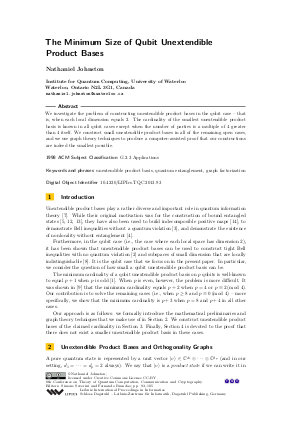The Minimum Size of Qubit Unextendible Product Bases
Author Nathaniel Johnston
-
Part of:
Volume:
8th Conference on the Theory of Quantum Computation, Communication and Cryptography (TQC 2013)
Part of: Series: Leibniz International Proceedings in Informatics (LIPIcs)
Part of: Conference: Conference on the Theory of Quantum Computation, Communication and Cryptography (TQC) - License:
 Creative Commons Attribution 3.0 Unported license
Creative Commons Attribution 3.0 Unported license
- Publication Date: 2013-11-13
File

PDF
LIPIcs.TQC.2013.93.pdf
- Filesize: 0.5 MB
- 13 pages
Document Identifiers
Subject Classification
Keywords
- unextendible product basis; quantum entanglement; graph factorization
Metrics
- Access Statistics
-
Total Accesses (updated on a weekly basis)
0PDF Downloads0Metadata Views
Abstract
We investigate the problem of constructing unextendible product bases in the qubit case - that is, when each local dimension equals 2. The cardinality of the smallest unextendible product basis is known in all qubit cases except when the number of parties is a multiple of 4 greater than 4 itself. We construct small unextendible product bases in all of the remaining open cases, and we use graph theory techniques to produce a computer-assisted proof that our constructions are indeed the smallest possible.
Cite As Get BibTex
Nathaniel Johnston. The Minimum Size of Qubit Unextendible Product Bases. In 8th Conference on the Theory of Quantum Computation, Communication and Cryptography (TQC 2013). Leibniz International Proceedings in Informatics (LIPIcs), Volume 22, pp. 93-105, Schloss Dagstuhl – Leibniz-Zentrum für Informatik (2013)
https://doi.org/10.4230/LIPIcs.TQC.2013.93
BibTex
@InProceedings{johnston:LIPIcs.TQC.2013.93,
author = {Johnston, Nathaniel},
title = {{The Minimum Size of Qubit Unextendible Product Bases}},
booktitle = {8th Conference on the Theory of Quantum Computation, Communication and Cryptography (TQC 2013)},
pages = {93--105},
series = {Leibniz International Proceedings in Informatics (LIPIcs)},
ISBN = {978-3-939897-55-2},
ISSN = {1868-8969},
year = {2013},
volume = {22},
editor = {Severini, Simone and Brandao, Fernando},
publisher = {Schloss Dagstuhl -- Leibniz-Zentrum f{\"u}r Informatik},
address = {Dagstuhl, Germany},
URL = {https://drops.dagstuhl.de/entities/document/10.4230/LIPIcs.TQC.2013.93},
URN = {urn:nbn:de:0030-drops-43173},
doi = {10.4230/LIPIcs.TQC.2013.93},
annote = {Keywords: unextendible product basis; quantum entanglement; graph factorization}
}
